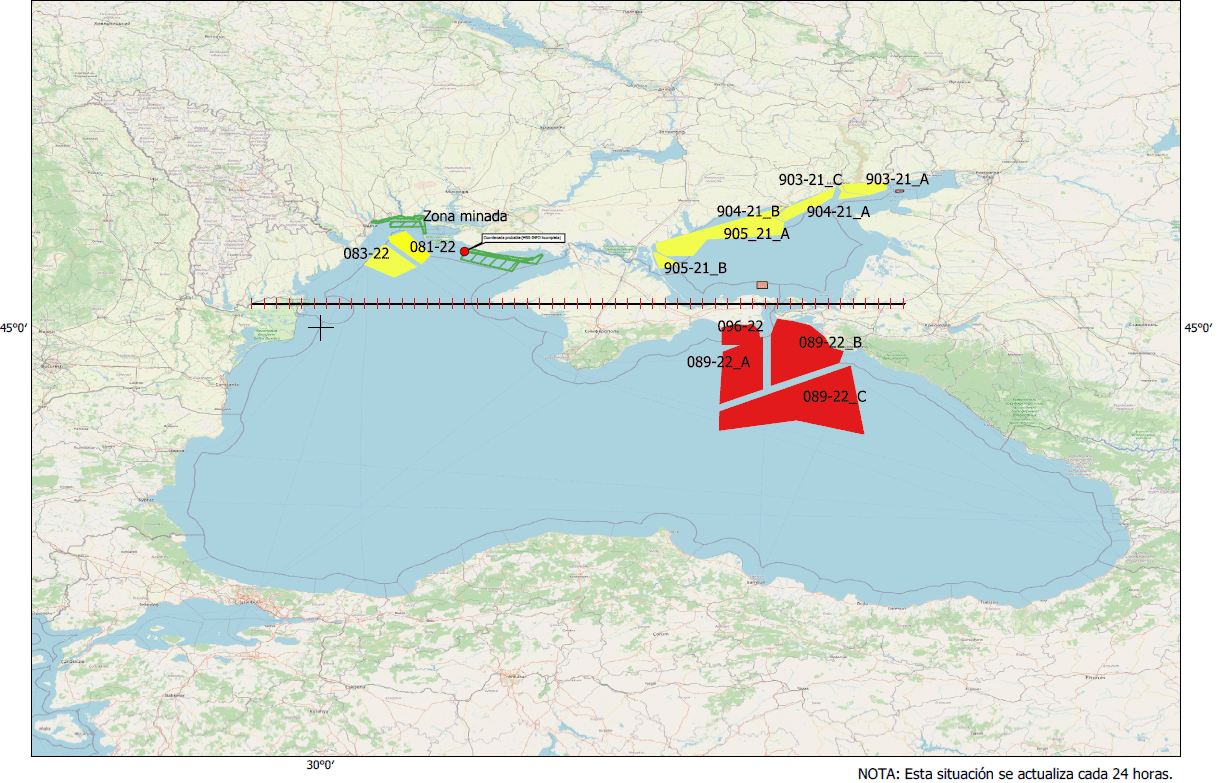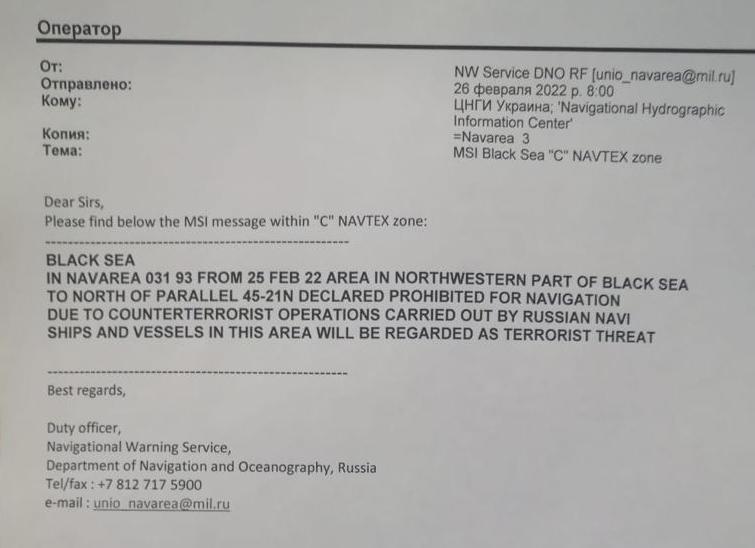UK To Remove Andrew From Role As Royal Navy Vice Admiral
LONDON, Nov 2 (Reuters) – Britain’s former prince Andrew is due to be stripped of his last remaining military position as part of King Charles’ decision to remove his brother from public...

by Captain John Konrad (gCaptain) While the US Navy and large NATO powers remain notably absent from the Black Sea few assets are available in the region to protect commercial shipping – while even NATO territorial waters are not being protected – the Joint Negotiating Group (JNG) and the International Transport Workers’ Federation (ITF) have designated areas in the Black Sea and the Sea of Azov as ‘Warlike Operations Areas’ triggering an increased security level and entitlements for seafarers in the war zone.
The designation was agreed at an emergency high-level meeting on the rapidly escalating crisis in Ukraine yesterday. Repatriation, payment of wages, safe transit and respect of individual seafarers’ rights, particularly for seafarers from the region, were the focus of discussions.
Also Read: U.S. Navy Left The Black Sea Unprotected Allowing Russia To Invade Ukraine
The escalation in hostilities and conflict in Ukraine has put enormous pressure on seafarers of all nations already laboring under the demands and challenges of the pandemic. The parties agreed that the welfare of seafarers and the protection of their rights in this unprecedented situation is paramount.
IBF Warlike Operations Areas were designated for the Sea of Azov (north of latitude 46°N), the Northern Black Sea Region and all ports in Ukraine. Under this classification seafarers onboard IBF covered ships are entitled to receive:
Due to the rapidly developing situation, these designations will be revisited every two weeks.
In addition to establishing ‘Warlike Operations Areas’ around Ukraine and adjacent waters, JNG and ITF also committed to engage in high-level discussions to monitor and review ways they can ensure seafarers’ safety and security in the rapidly evolving crisis.
The potential need for refugee arrangements for Ukrainian seafarers and their families was also considered. The social partners agreed to increase pressure on governments to waive visas for Ukrainian seafarers to ease their repatriation.
“I wish to have no connection with any ship that does not sail fast; for I intend to go in harm’s way.” is a famous quote by US Merchant Mariner turned US Navy hero John Paul Jones. Unfortunately, however, this time the US Navy is staying well clear of hostile waters.
The US Navy and NATO have a joint Maritime Command in place but have remained silent since the Invasion of Ukraine by Russian forces. The last update from NATO was issued almost a week ago. That update warns of AIS spoofing and suggests that commercial ship captains use “carefully consider and plan voyages based on an assessment of the escalating security situation”.
According to Bosphorus Naval News not a single US Navy, Coast Guard, or NATO warship has entered the black sea since hostilities began. The closest Carrier strike group is likely in the central Mediterranean, over a thousand nautical miles from harm’s way. This is despite the fact that ships both chartered and owned by NATO members have been hit in missile attacks.
If a NATO member’s commercial aircraft was hit with a missile there would be an immediate international response but missile attacks on ships have not resulted in even a single US Navy or NATO shipping press release.
The UN Refugee Agency states the conflict in Ukraine could plunge Europe into its worst refugee crisis of this century as hundreds of thousands of Ukrainians seek safety elsewhere. Many of these refugees will likely flee via water but without US Navy or NATO naval protection – with no Hospital ships, high speed ferries, or Coast Guard recovery cutters – being dispatched to the region… they will be at the mercy of not only the winter elements but also Russian naval forces.
Right now the ‘Warlike Operations Area’ does not extend to the territorial waters of neighboring Romania, a NATO member, but there is a growing concentration of ships hiding inside the territorial waters of Bulgaria and Romania which Russia could look to target if NATO does not start protecting the sea routes off the coast of NATO member nations.
As northern supply lines are challenged, Ukraine could start looking for unconventional ways to disrupt shipping in order to restrict the Russian sealift of ammunition and supplies in the Black Sea.
Also Read: Ukraine’s Secret Weapon: Seafarers
Meanwhile, Russian forces continue to move into the Ukrainian ports they need to resupply troops with fuel, ammunition, and equipment. Russia’s push to seize key Ukrainian cities accelerated on Wednesday, with the Russian military claiming that its forces were fully in control of Kherson, an important port near the Black Sea, where the mayor told the New York Times his the city was “waiting for a miracle” so they can collect bodies and restore basic services.
“The Russian control of Mariupol will be confirmed if we start seeing ships moving between Rostov and the Kerch Strait,” says Sal Mercogliano, author of Fourth Arm of Defense: Sealift and Maritime Logistics. “If that happens, then expect Russian forces to shift their focus toward Odessa and beyond.”
According to several sources and a NAVTEX message reportedly issued by Russia, the Russian Navy has already started performing “counterterrorist operations” against shipping beyond Ukraine. According to a report by Dryad, three vessels have been detained by the Russian Navy and a fourth ship sustained light damage, though it is unclear how and when this damage was sustained.

Russia’s “counterterrorism operations” against commercial ships in Ukrainian waters is troubling but expected. More troubling is the report that the operations have already extended to the territorial waters of a NATO member Romania.
A statement, issued by the Ukrainian government, said that following “counterterrorist operation” is “in defiance of norms and conventions of international law”. The statement also claims that Russia captured the cargo ship M/V Athena while she was sailing in Romanian waters.
More troubling still is the fact the US Navy and NATO have not responded to these reports with naval ships to ensure Freedom of Navigation in the black sea. Most troubling of all is the fact that the US Navy and NATO have NOT even acknowledged the attacks on NATO flagged ships transiting the area.
The only advice they have to offer is curt, unhelpful, and nearly a week old.
Follow @johnkonrad on twitter or LinkedIn

Sign up for gCaptain’s newsletter and never miss an update

Subscribe to gCaptain Daily and stay informed with the latest global maritime and offshore news
Essential news coupled with the finest maritime content sourced from across the globe.
Sign Up